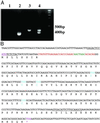A spliceosomal intron in Giardia lamblia
- PMID: 11854456
- PMCID: PMC122587
- DOI: 10.1073/pnas.042700299
A spliceosomal intron in Giardia lamblia
Abstract
Short introns occur in numerous protist lineages, but there are no reports of intervening sequences in the protists Giardia lamblia and Trichomonas vaginalis, which may represent the deepest known branches in the eukaryotic line of descent. We have discovered a 35-bp spliceosomal intron in a gene encoding a putative [2Fe-2S] ferredoxin of G. lamblia. The Giardia intron contains a canonical splice site at its 3' end (AG), a noncanonical splice site at its 5' end (CT), and a branch point sequence that fits the yeast consensus sequence of TACTAAC except for the first nucleotide (AACTAAC). We have also identified several G. lamblia genes with spliceosomal peptides, including homologues of eukaryote-specific spliceosomal peptides (Prp8 and Prp11), several DExH-box RNA-helicases that have homologues in eubacteria, but serve essential functions in the splicing of introns in eukaryotes, and 11 predicted archaebacteria-like Sm and like-Sm core peptides, which coat small nuclear RNAs. Phylogenetic analyses show the Giardia Sm core peptides are the products of multiple, ancestral gene duplications followed by divergence, but they retain strong similarity to Sm and like-Sm peptides of other eukaryotes. Although we have documented only a single intron in Giardia, it likely has other introns and fully functional, spliceosomal machinery. If introns were added during eukaryotic evolution (the introns-late hypothesis), then these results push back the date of this event before the branching of G. lamblia.
Figures


Comment in
-
Spliceosomal introns in a deep-branching eukaryote: the splice of life.Proc Natl Acad Sci U S A. 2002 Mar 19;99(6):3359-61. doi: 10.1073/pnas.072084199. Proc Natl Acad Sci U S A. 2002. PMID: 11904397 Free PMC article. No abstract available.
References
Publication types
MeSH terms
Substances
Associated data
- Actions
Grants and funding
LinkOut - more resources
Full Text Sources
Other Literature Sources

